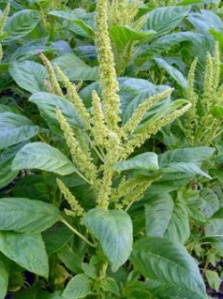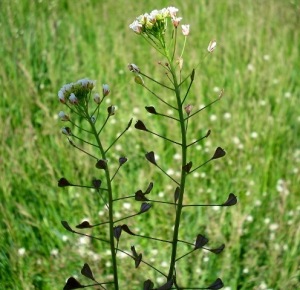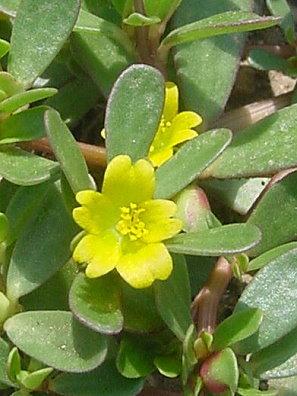 Dandelions! The whole plant is edible, though it is
usually less bitter in the spring. It is a powerhouse of vitamins C,
A , and betacarotene. Eat the leaves and flowers in salads, or steam
the leaves like spinach.
Dandelions! The whole plant is edible, though it is
usually less bitter in the spring. It is a powerhouse of vitamins C,
A , and betacarotene. Eat the leaves and flowers in salads, or steam
the leaves like spinach. Elderberries
An
elderberry shrub can grow easily grow about 10 feet tall and will
yield tons of food. These are easiest to identify in the spring as
they blossom with white clustered flowers that resemble an umbrella.
The dried flowers make a healthful tea. Harvest the berries when
they’re ripe around September, as Elderberries are known for their
flu and cold healing properties. You can make jelly, syrup or
extracts from the elderberries, but don't eat them raw.
Elderberries
An
elderberry shrub can grow easily grow about 10 feet tall and will
yield tons of food. These are easiest to identify in the spring as
they blossom with white clustered flowers that resemble an umbrella.
The dried flowers make a healthful tea. Harvest the berries when
they’re ripe around September, as Elderberries are known for their
flu and cold healing properties. You can make jelly, syrup or
extracts from the elderberries, but don't eat them raw.
Pinon
pine needles can be steeped in hot water to make a drink that is rich
in vitamin C and will stave off scurvy. Pine nuts have healthful
oils and protein.

Red
Clover blossoms can be eaten fresh or steeped in hot water for tea.
You can toss both the green leaves and blossoms into a salad, but be
careful if you take blood thinners, as this plant has natural
coumadin.

Cattails
are usually found near the edges of freshwater wetlands. Cattails
were a staple in the diet of many Native American tribes. Most of a
cattail is edible. You can boil or eat raw the rootstock, or
rhizomes, of the plant. The rootstock is usually found underground.
The best part of the stem is near the bottom where the plant is
mainly white. Either boil or eat the stem raw. Boil the leaves like
you would spinach. The corn-dog looking female flower spike can
be broken off and eaten like corn on the cob in the early summer when
the plant is first developing. It actually has a corn-like taste to
it.

Plantain
Is another one of those plants that seem to thrive right on the edge
of gardens and driveways, but it’s also edible. Pick the green,
rippled leaves and leave the tall flower stems. Blanch the leaves and
sauté with some butter.

Pigweed
is a valuable plant. The whole thing – leaves, roots, stem, and
seeds are edible. The Amaranth seed is small and very nutritious and
easy to harvest. It is used to make flour for baking uses. Roasting
the seeds can enhance the flavor. You can sprout the raw seeds to
use them in salads, and in sandwiches. Young leaves can be eaten raw
or cooked like spinach, sautéed, etc. Fresh or dried pigweed leaves
can be used to make an herbal tea.

Shepherd's Purse's young leaves can be used raw in salads, or cooked in soups, in mixed cooked greens or in any dish that calls for cooking greens. Although the leaves may be eaten throughout the summer, the mature leaves have a peppery taste that does not appeal to all palates.

Mullein
leaves and flowers are edible. The flowers are fragrant and taste
sweet, The leaves are furry and taste slightly bitter. This plant is
best known as an herbal tea and can be consumed as a nutritious
beverage containing vitamins B2, B5, B12, and D, choline, hesperidin,
paraaminobenzoic acid, magnesium, and sulfur. Mullein tea is
primarily valued as an effective treatment for coughs and lung
disorders. The native people dried the leaves and smoked them to
relieve lung ailments. The pioneers valued mullein as a poultice to
help glandular problems, especially mastitis.

Purslane
can be considered an obnoxious weed but it can provide much needed
vitamins and minerals in a survival situation. Ghandi actually
numbered purslane among his favorite foods. It’s a small plant with
smooth fat leaves that have a refreshingly sour taste. Purslane grows
from the beginning of summer to the start of fall. You can eat
purslane raw or boil it to remove the sour taste. It is one of the
highest vegetable sources for omega 3's.

Sheep
sorrel is native to Europe and Asia but has been naturalized in North
America. It’s a common weed in fields, grasslands, and woodlands.
and flourishes in highly acidic soil. Sheep sorrel has a tall,
reddish stem and can reach heights of 18 inches. It contains oxalates
and shouldn’t be eaten in large quantities. You can eat the leaves
raw. They have a nice tart, almost lemony flavor.

Wild
mustard ! You can eat all parts of the plant- seeds, flowers, and
leaves.

No comments:
Post a Comment